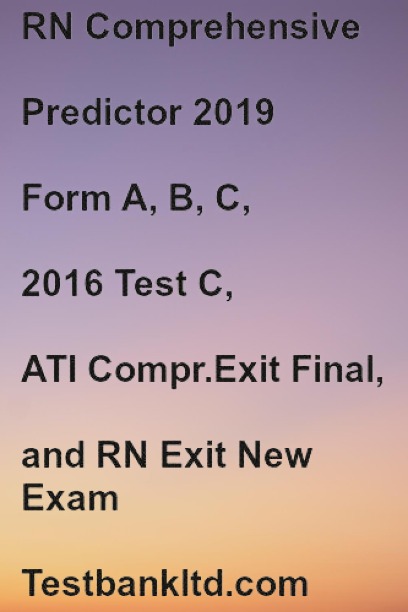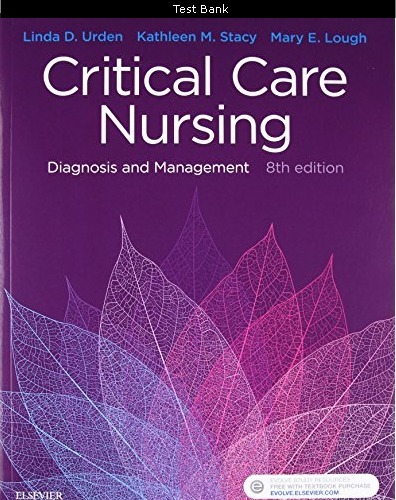RN Comprehensive Predictor 2019 Form A, B, C, 2016 Test C, ATI Compr.Exit Final, and RN Exit New Exam
Digital item No Waiting Time Instant DownloadATI EXAM
In Stock
Original price was: $75.00.$23.00Current price is: $23.00.
RN Comprehensive Predictor 2019 Form A, B, C, 2016 Test C, ATI Compr.Exit Final, and RN Exit New Exam
RN Comprehensive Predictor 2019 Form A1. A nurse in a pediatric unit is preparing to insert an IV catheter for 7-year-old. Which of the following actions should the nurse take?
- (Unable to read)
- Tell the child they will feel discomfort during the catheter insertion.
- Use a mummy restraint to hold the child during the catheter insertion.
- Require the parents to leave the room during the procedure.
2. A nurse is caring for a client who has arteriovenous fistula Which of the following findings should the nurse report?
- Thrill upon palpation.
- Absenceofabruit.
- Distended blood vessels
- Swishing sound upon auscultation.
3. A nurse is providing discharge teaching for a client who has an implantable cardioverter defibrillator which of the following statements demonstrates understanding of the teaching?
- “I will soak in the tub rather and showering”
- “I will wear loose clothing around my ICD”
- “I will stop using my microwave oven at home because of my ICD”
- “I can hold my cellphone on the same side of my body as the ICD”
4. A nurse is caring for a client who is at 14 weeks gestation and reports feelings of ambivalence about being pregnant. Which of the following responses should the nurse make?
- “Describe your feelings to me about being pregnant”
- “You should discuss your feelings about being pregnant with your provider”
- “Have you discussed these feelings with your partner?”
- “When did you start having these feelings?”
5. A nurse is planning care for a client who has a prescription for a bowel- training program following a spinal cord injury. Which of the following actions should the nurse include in the plan of care?
- Encourage a maximum fluid intake of 1,500 ml per day.
- Increase the amount of refined grains in the client’s diet.
- Provide the client with a cold drink prior to defecation.
- Administer a rectal suppository 30 minutes prior to scheduled defecation times.
6. A nurse is caring for a client who is in active labor and requests pain management. Which of the following actions should the nurse take?
- Administer ondansetron.
- Place the client in a warm shower.
- Apply fundal pressure during contractions.
- Assist the client to a supine position.
7. a nurse in an emergency department is performing triage for multiple clients following a disaster in the community. To which of the following types of injuries should the nurse assign the highest priority?
- Below-the knee amputation
- Fractured tibia
- 95% full-thickness body burn
- 10cm (4in) laceration to the forearm
8. a nurse manager is updating protocols for the use of belt restraints. Which of the following guidelines should the nurse include?
- Remove the client’s restraint every 4hr
- Document the client’s condition every 15 min
- Attach the restrain to the bed’s side rails
- Request a PRN restrain prescription for clients who are aggressive
9. A nurse is teaching an in-service about nursing leadership. Which of the following information should the nurse include about an effective leader?
- Acts as an advocate for the nursing unit.
- (Unable to read) for the unit
- Priorities staff request over client needs.
- Provides routine client care and documentation.
10. A nurse is reviewing the laboratory findings of a client who has diabetes mellitus and reports that she has been following her (unable to read) care. The nurse should identify which of the following findings indicates a need to revise the client’s plan of care.
- Serum sodium 144 mEq/
- (Unable to read)
- Hba1c10%
- Random serum glucose 190 mg/dl.
11. A nurse in a provider’s office is reviewing the laboratory results of a group of clients. The nurse should identify that which of the following sexually transmitted infections is a nationally notifiable infectious disease that should be reported to the state health department?
- Chlamydia
- Human papillomavirus
- Candidiasis
- Herps simplex virus
12. A nurse is teaching a newly licensed nurse about therapeutic techniques to use when leading a group on a mental health unit. Which of the following group facilitation techniques should the nurse include in the teaching?
- Share personal opinions to help influence the group’s values
- Measure the accomplishments of the group against a previous group
- Yield in situations of conflicts to maintain group harmony
- Use modeling to help the clients improve their interpersonal skills
13. A nurse is planning for a client who practices Orthodox Judaism. The client tells the nurse that (Unable to read) Passover holiday. Which of the following action should the nurse include in the plan of care?
- Provide chicken with cream sauce.
- Avoid serving fish with fins and scales.
- Provide unleavened bread.
- Avoid serving foods containing lamb.
14. A nurse is caring for a client who has a pulmonary embolism. The nurse should identify the effectiveness of the treatment
- A chest x-ray reveals increased density in all fields.
- The client reports feeling less anxious.
- Diminished breath sounds are auscultated bilaterally
- ABG results include Ph 7.48 PaO2 77 mm Hg and PaCO2 47 mm Hg.
15. A nurse in an emergency department is assessing a client who reports ingesting thirty diazepam tablets (Unable to read) a respiratory rate of 10/min. After securing the client’s airway and initiating an IV, which of the following actions should the nurse do next.
- Monitor the client’s IV site for thrombophlebitis.
- Administer flumazenil to the client.
- Evaluate the client for further suicidal behavior.
- Initiate seizure precautions for the client.
RN Comprehensive Predictor 2019 Forms A, B, C, 2016 Test C, ATI Comprehensive Exit Final, and RN Exit New Exam
The RN Comprehensive Predictor and Exit exams are designed to assess the readiness of nursing students for the NCLEX-RN exam. These exams, developed by ATI (Assessment Technologies Institute), cover a broad range of nursing knowledge and skills. Below is a detailed overview of each exam, including the structure, content, benefits, and practical applications.
RN Comprehensive Predictor 2019 Forms A, B, and C
Structure and Content
- Each form includes 180 questions that simulate the style and complexity of the NCLEX-RN exam.
- The questions are a mix of multiple-choice, select-all-that-apply (SATA), fill-in-the-blank, hot spot, and ordered response types.
- Topics covered include:
- Fundamentals of Nursing
- Medical-Surgical Nursing
- Maternal and Newborn Nursing
- Pediatric Nursing
- Psychiatric and Mental Health Nursing
- Pharmacology
- Community Health Nursing
- Critical Care Nursing
- Ethical and Legal Issues
Benefits
- Comprehensive practice that mirrors the NCLEX-RN format.
- Detailed rationales for each question to aid in understanding.
- Helps identify areas needing further study.
Practical Applications
- Use in classroom assessments, self-study, and review sessions.
- Integration with Learning Management Systems (LMS) for seamless delivery and grading.
RN Comprehensive Predictor 2016 Test C
Structure and Content
- Similar to the 2019 forms, Test C includes 180 questions covering a wide range of nursing topics.
- Emphasizes critical thinking and application of knowledge in clinical scenarios.
Benefits
- Provides a historical comparison for progress tracking.
- Offers additional practice questions and rationales.
Practical Applications
- Supplement to the 2019 forms for broader question exposure.
- Useful for comparative analysis and trend identification in student performance.
ATI Comprehensive Exit Final
Structure and Content
- A cumulative exam designed to be taken towards the end of the nursing program.
- Includes 180 questions that comprehensively cover all major areas of nursing practice.
- Similar in format to the NCLEX-RN, ensuring realistic practice.
Benefits
- Helps gauge overall readiness for the NCLEX-RN.
- Provides a final benchmark before the actual licensure exam.
- Detailed feedback and rationales enhance understanding and preparation.
Practical Applications
- Use as a final assessment to identify any last-minute areas for review.
- Helps educators tailor final review sessions based on student performance.
RN Exit New Exam
Structure and Content
- A newer version of the exit exam, incorporating the latest updates in nursing practice and NCLEX-RN format.
- 180 questions covering all critical nursing areas, including emerging trends and practices.
Benefits
- Reflects the most current standards and practices in nursing.
- Provides updated practice aligned with the latest NCLEX-RN exam changes.
Practical Applications
- Use in conjunction with older versions for a comprehensive review.
- Ensures students are prepared for the most current NCLEX-RN format and content.
Benefits of the Test Banks
For Educators
- Comprehensive Resource: Covers all critical areas tested in the NCLEX-RN, ensuring thorough preparation.
- Time-saving Tool: Ready-to-use questions that can be integrated into quizzes, tests, and review sessions.
- Enhanced Evaluation: Facilitates thorough assessment of students’ understanding and application of nursing knowledge.
For Students
- Realistic Exam Experience: Questions designed to reflect the style and difficulty of the actual NCLEX-RN, providing a realistic practice experience.
- Practice and Preparation: Extensive practice opportunities to reinforce learning and identify areas needing further study.
- Critical Thinking Development: Scenario-based questions and case studies enhance critical thinking and clinical decision-making skills.
- Immediate Feedback: Detailed rationales for each question help students understand the reasoning behind correct answers, promoting deeper learning.
Practical Applications
Integration with Learning Management Systems (LMS)
- The test banks can be integrated with LMS platforms such as Blackboard, Canvas, or Moodle for seamless delivery of assessments and automatic grading of objective questions.
Formative and Summative Assessments
- Use the test banks for regular quizzes, in-class activities, and practice exams to monitor students’ progress and understanding throughout the course.
- Employ the test banks for mid-term and final exams to provide a comprehensive evaluation of students’ nursing knowledge.
Detailed Preparation Strategy
Regular Practice
- Consistent practice with test bank questions helps students become familiar with the exam format and improve their test-taking skills.
Study Groups
- Collaborating with peers in study groups to discuss and analyze questions can enhance understanding and retention of complex concepts.
Simulated Exams
- Taking full-length, timed practice exams using the test banks can help simulate the actual exam environment, reducing anxiety and improving time management.
Review and Reflection
- Reviewing incorrect answers and understanding the rationale behind them helps solidify knowledge and correct misunderstandings.
Conclusion
The “RN Comprehensive Predictor 2019 Forms A, B, C, 2016 Test C, ATI Comprehensive Exit Final, and RN Exit New Exam” are invaluable resources for both educators and students in the field of nursing. By offering a comprehensive range of questions, detailed rationales, and practical applications, these test banks ensure thorough preparation and enhance the overall learning experience. They support the development of critical thinking and clinical decision-making skills, ultimately preparing students for success on the NCLEX-RN and in their future nursing careers.



Reviews
There are no reviews yet.